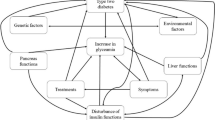Abstract
THIS PAPER BEGINS with a description of our assumptions about meaningful learning in higher education and meaningful learning from hypertext. We then describe different classes of applications of hypertext to support learning including hypertext as vehicle, information access hypertexts, intentional learning environments, and knowledge construction environments. Finally, we discuss some limitations of hypertext for facilitating learning, issues and processes in evaluating meaningful learning outcomes from hypertext environments.
Similar content being viewed by others
References
Barba, R.H. (1990).Insects. Denver, CO: Hypermedia and Instructional Software Clearinghouse.
Brown, A., Collins, A., & Duguid, P. (1987). Situated cognitionEducational Researcher, 18(1), 32–42.
Bush, V. (1945). As we may think.Atlantic Monthly, 176(1), 101–108.
Conklin, J. & Begeman, M. (1987).IBIS: A hypertext tool for team design deliberation. InProceedings of Hypertext ’87 (pp. 119–141). Chapel Hill, NC: University of North Carolina, Computer Science Department.
Duffy, T., & Jonassen, D.H. (1992).Constructivism and the technology of instruction: A conversation. Hillsdale, NJ: Lawrence Erlbaum Associates.
Duffy, T., Jonassen, D.H., & Lowyck, J. (in press).The design of constructivistic learning environments.Berlin: Springer-Verlag.
Dunlap, J., & Jonassen, D.H. (1992).Collaborative knowledge construction in an argument-based hypertext.Paper presented at the annual meeting of the Association for the Development of Computer-based Instructional Systems, Norfolk, VA, November, 1992.
Fosnot, C.T. (1989).Enquiring teachers, enquiring learners: A constructivist approach for teachers. New York: Teachers College Press.
Gery, G. (1991).Electronic performance support systems: How and why to remake the workplace through the strategic application of technology. Boston: Weingarten.
Gick, M.L., & Holyoak, K.J. (1983). Schema induction and analogical transfer.Cognitive Psychology, 12, 306–365.
Grabinger, R. S. (1992).Desert Shield. Denver, CO: Hypermedia and Instructional Software Clearinghouse.
Hartman, D.K., & Spiro, R.J. (1989, March).Explicit text structure instruction for advanced knowledge acquisition in complex domains: A post-structuralist perspective.Paper presented at the annual meeting of the American Educational Research Association, San Francisco, CA.
Heath, S. (1992).InfoAgent. Denver, CO: Hypermedia and Instructional Software Clearinghouse.
Jacobson, M.J. (1990).Knowledge acquisition, cognitive flexibility, and the instructional applications of hypertext: A comparison of contrasting designs for computer-enhanced learning environments. (Unpublished doctoral dissertation, University of Illinois).
Jonassen, D.H. (1989).Hypertext/hypermedia. Englewood Cliffs NJ: Educational Technology Publications.
Jonassen, D.H. (1991a). Hypertext as instructional design.Educational Technology: Research and Development, 39(1), 83–92.
Jonassen, D.H. (1991b). Objectivism vs. constructivism: Do we need a new philosophical paradigm?Educational Technology Research and Development, 39(3), 5–14.
Jonassen, D.H. (in press). Cognitive flexibility theory and its implications for designing CBI. In S. Dijkstra (Ed.),Instructional models in computer based learning environments.Heidelberg, FRG: Springer-Verlag.
Jonassen, D.H., & Mandl, H. (1990).Designing hypertext for learning. Berlin: Springer-Verlag.
Jonassen, D.H., Mayes, T., & McAleese, R.M. (in press). A manifesto for the constructivistic use of technology in higher education. In T. Duffy, D. Jonassen, & J. Lowyck (Eds.),Designing constructivist learning environments.Heidelberg, FRG: Springer-Verlag.
Jonassen, D.H., Ambruso, D.R., & Olesen, J. (1992). Designing a hypertext on transfusion medicine using cognitive flexibility theory.Journal of Educational Hypermedia and Multimedia, 1(3), 309–322.
Jonassen, D.H., & Wang, S. (in press). Acquiring structural knowledge from semantically structured hypertext.Journal of Computer-based Instruction.
Landow, G. (1989). Hypertext in literary education, criticism, and scholarship.Computers and the Humanities, 23, 173–198.
Landow, G. (1990). Popular fallacies about hypertext. In D.H. Jonassen & H. Mandl (Eds.),Designing hypertext for learning, (pp. 39–60). Heidelberg, FRG: Springer-Verlag.
Kinzie, M.B. (1990). Requirements and benefits of effective interactive instruction: Learner control, self-regulation, and continuing motivation.Educational Technology: Research and Development, 38, 5–21.
Nelson, T. (1974).Dream machines. South Bend, IN: The Distributors.
Nelson, T. (1978). Electronic publishing and electronic literature. In E.C. Land (Eds.),Information technology in health science education (pp. 83–95). New York: Plenum.
Scardamalia, M., Bereiter, C., McLean, R., Swallow, J., & Woodruff, E. (1989). Computer-supported intentional learning environments.Journal of Educational Computing Research, 5, 51–68.
Scardamalia, M., & Bereiter, C. (1991). Higher levels of agency for children in knowledge building: A challenge for the design of new knowledge media.Journal of the Learning Sciences, 1(1), 37–68.
Schank, R., & Jona, M. (1991). Empowering the student: New perspectives on the design of teaching systems.Journal of the Learning Sciences, 1(1), 7–35.
Schon, D. (1983). The reflective practitioner: How professionals think in action. New York: Basic Books.
Spiro, R.J., & Jehng, J.C. (1990). Cognitive flexibility and hypertext: Theory and technology for the non-linear and multi-dimensional traversal of complex subject matter. In D. Nix & R.J. Spiro (Eds.),Cognition, education, and multimedia: Explorations in high technology (pp. 163–205). Hillsdale, NJ: Lawrence Erlbaum.
Spiro, R.J., Vispoel, W., Schmitz, J., Samarapungavan, A., & Boerger, A. (1987). Knowledge acquisition for application: Cognitive flexibility and transfer in complex content domains. In B.C. Britton (Ed.),Executive control processes. (pp. 177–199). Hillsdale, NJ: Lawrence Erlbaum Associates.
Spiro, R.J., Coulson, R.L., Feltovich, P.J., & Anderson, D.K. (1988).Cognitive flexibility theory: Advanced knowledge acquisition in ill-structured domains. Tech Report No. 441. Champaign, IL: University of Illinois, Center for the Study of Reading.
Wang, S., & Jonassen, D.H. (in press).Modelling flexibility to support deeper processing from a cognitive flexibility hypertext.Paper presented at the annual meeting of the Association for the Development of Computer-based Instructional Systems, Norfolk, VA, November, 1992.
Wertsch, J.V. (1985).Vygotsky and the social formation of mind. Cambridge MA: Harvard University Press.
Wittrock, M.C. (1974). Learning as a generative activity.Educational psychologist, 11, 87–95.
Author information
Authors and Affiliations
Additional information
David H. Jonassen is Professor and Chair of Instructional Technology at the University of Colorado at Denver. He is the author/editor of over a dozen books and 200 articles/chapters/papers on instructional design, educational psychology and the design of computer based systems such as hypertext. His research interests include externalizing knowledge representation and the design of learning environments.
R. Scott Grabinger is an Associate Professor of Instructional Technology at the University of Colorado at Denver. He is the co-author of two books and numerous articles and papers on expert systems, hypertext design and learning systems. He is the Director of the Hypermedia Instructional Software Clearinghouse.
Rights and permissions
About this article
Cite this article
Jonassen, D.H., Grabinger, R.S. Applications of hypertext: Technologies for higher education. J. Comput. High. Educ. 4, 12–42 (1993). https://doi.org/10.1007/BF02941063
Issue Date:
DOI: https://doi.org/10.1007/BF02941063




